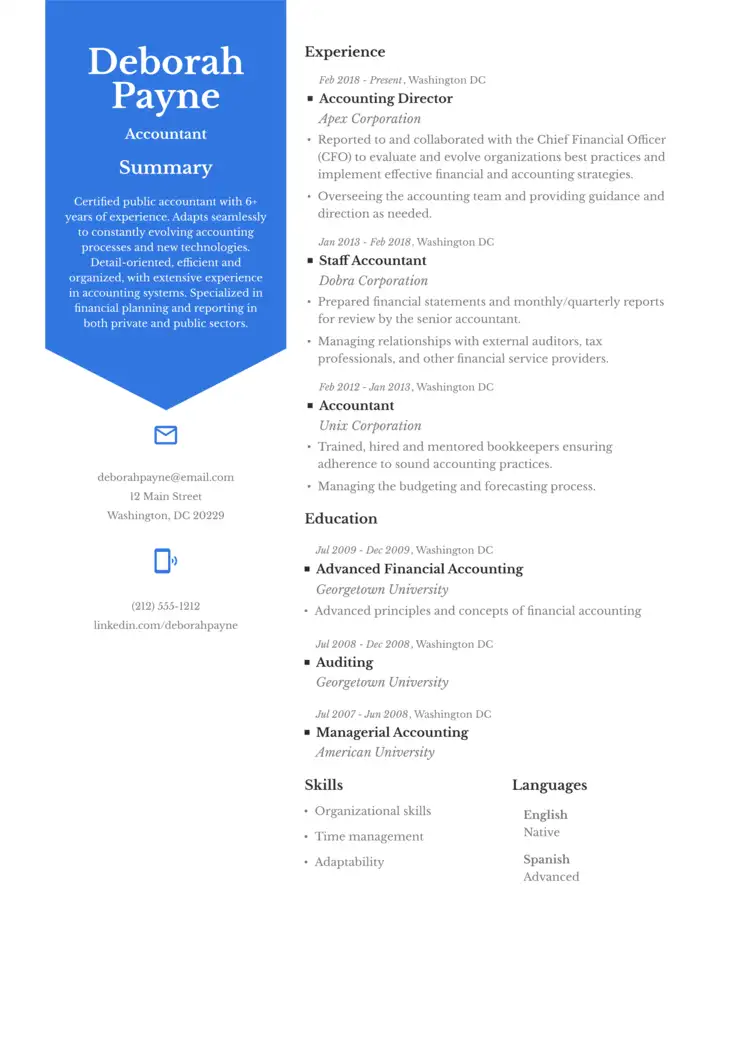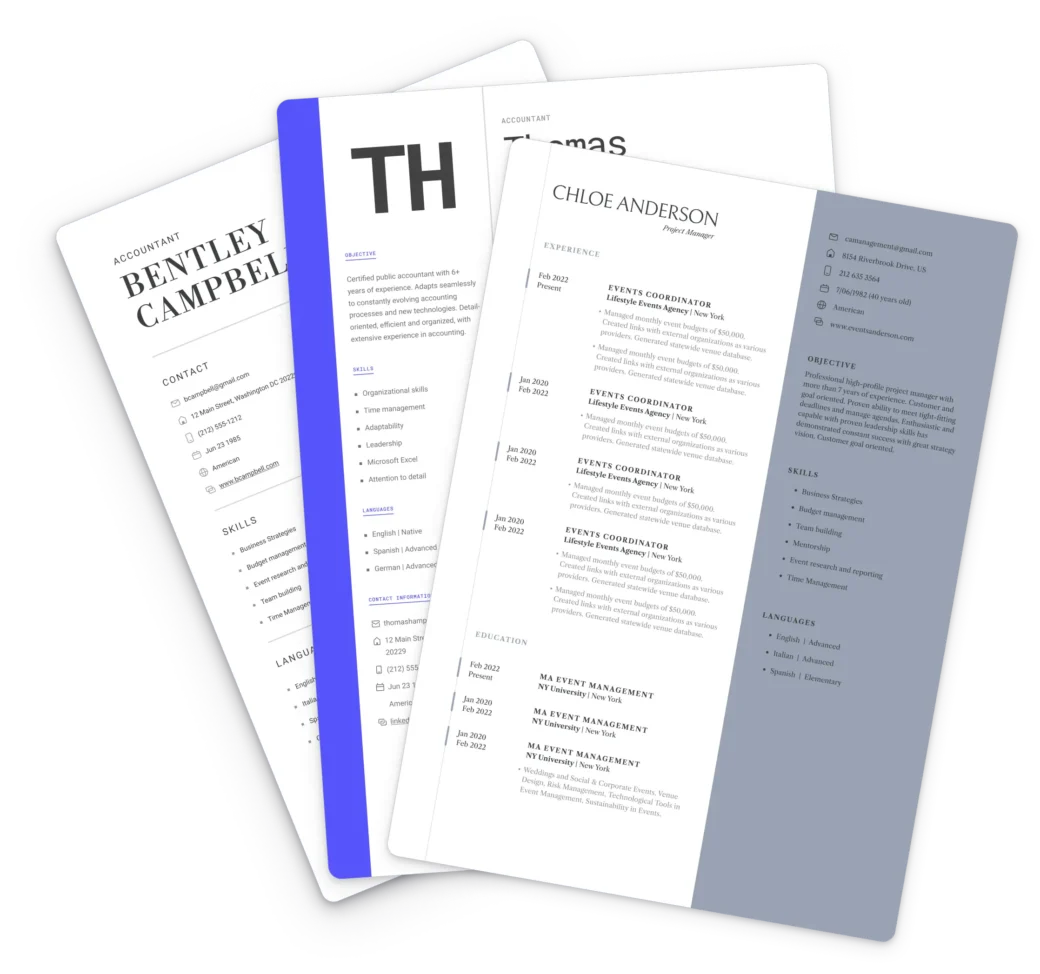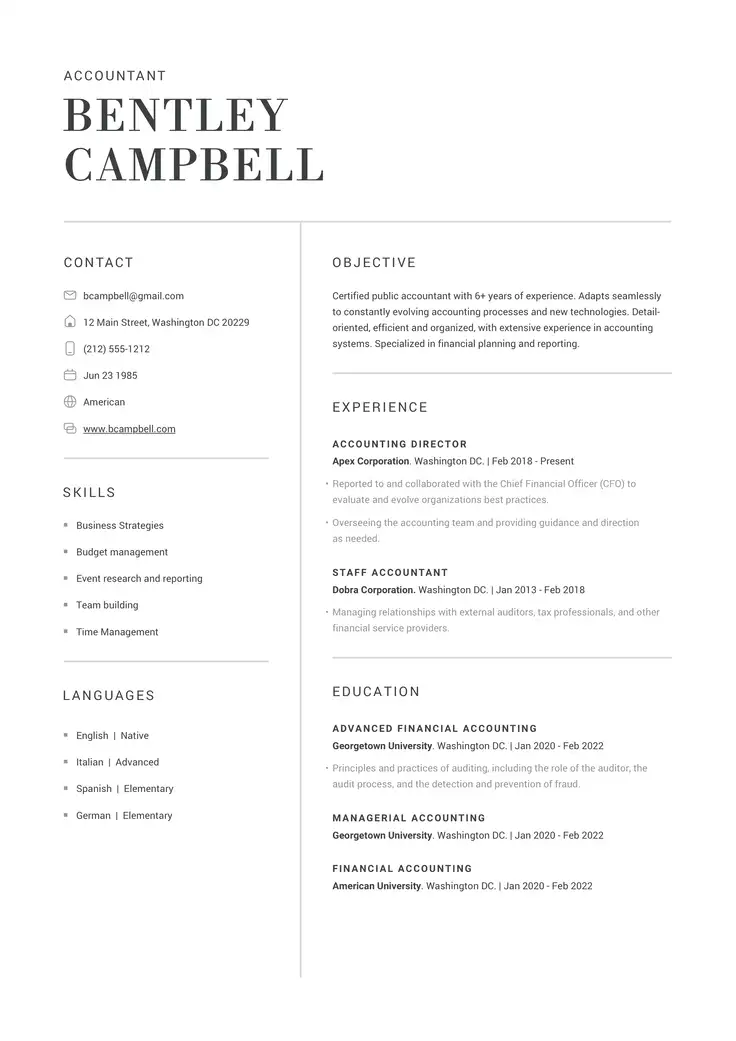Simple Resume Writing Guide
Get to grips with the simple resume format and design an effective resume from simple templates

For some, resume writing can be a complex task that takes them out of their comfort zone.
Maybe you’re just getting started in the working world, and it’s your first time creating one. Or perhaps you’ve been at the same job for years, and you haven’t had to write a resume in a while.
Whatever your situation, you are not alone, and you don’t need to overcomplicate this process. This guide will show you exactly how to write a simple resume that does exactly what it is supposed to do: land you interviews!
We also provide you with a simple resume sample, which you can copy in text format as a base for your own.
What Is a Simple Resume?
How would you define a simple resume? A simple resume is your professional first impression, clean, confident, and easy to read. This is also true in terms of the design, the formatting, and the content.
Usually, simple resumes are used to get straight to the point, displaying the basic information a hiring manager needs to know about the candidate.
To determine whether yours is a simple resume, compare it to the following checklist:
- Clean
- Easy-to-read format
- Avoids unnecessary design elements
- Straightforward and informative wording
-
💡 Our expert’s advice

Your goal is to make the reader’s (hiring manager or recruiter) life easier! Right away you want them to be able to recognize what you do, what makes you stand out, and how you’ll address their needs!
Why Choose a Simple Resume?
Your professional, simple resume has two jobs: it has to get past the robot (ATS) and wow the human (hiring manager).
The first hurdle is the Applicant Tracking System or ATS. Seventy-five percent of recruiters and 99 percent of Fortune 500 companies employ these computer platforms to help screen applications before they ever make it to human hands.
If you’re using a resume with complex graphics or tables, the ATS might not be able to parse it correctly. That’s why keeping it simply isn’t just about style, it’s a strategy.
For an ATS to parse (process) your resume, it is best to use a simple layout. This means having clear headings, bullet points, and clear sections.
An online resume builder can help with this process, making it quick and easy to edit resume versions that are ATS-friendly. We even have a basic template designed specifically for ATS compliance.
The next hurdle is impressing the human hiring manager. According to the most recent eye-tracking study from The Ladders, “recruiters are still skimming,” spending just 7.4 seconds, on average, looking at each resume.
Your resume needs to be easy to read and provide the right information in that brief span of time.
So, your simple resume should be ATS-friendly, easy to read, and versatile enough to be used for any industry.

Build your perfect resume with ease
Craft the perfect resume effortlessly with our builder. Get started today!
Who Should Use a Simple Resume?
Who are simple resumes best suited to? Almost everyone can benefit from a clean, straightforward resume, but those who benefit the most are usually students, teenagers, recent graduates, and those with little work experience.
After all, there is no need for elaborate designs when showcasing education and internships.
Job seekers in traditional fields such as finance, healthcare, and administration can benefit from a straightforward resume as well. A simple resume succinctly says, “I can do this job, and here’s why,” without including distracting irrelevant information.
Finally, simple resumes are also well suited to career changers–individuals who are pivoting to a different position or industry mid-career. A simple template helps them focus on their transferable skills without adding unnecessary details.
How to Write a Simple Resume (Step-by-Step)
Now that you’ve been thinking about what a simple resume is and who should use one, we’re going to guide you through how to create a basic resume step by step.
1. Choose a basic structure
Sometimes known as a traditional resume or a non-creative option, simple resumes can be described as minimalist. They are elegant because they portray information in a plain and concise manner without those extra flourishes that don’t relate to the candidate’s experience or the vacancy on offer.
We recommend using a reverse-chronological format. In each section, you’ll list your most recent experiences first. This is the type of format that most recruiters expect. As such, they’ll be able to find the information they need quickly.
2. Include these basic resume sections
There are a handful of sections that every resume should include, such as:
- Contact information–your name, email address, phone number, and LinkedIn profile URL. You can also include relevant social media accounts that highlight your extracurricular activities or personal projects. Only include professional or business-focused accounts, not personal ones.
-
💡 Our expert’s advice

You can also use this section to include a professional portfolio or website if you have one! Just make sure it’s up-to-date.
- Resume Summary–a short paragraph of one to two sentences summarizing your expertise, skills, achievements, and your professional promise (what you bring to organizations).
- Skills Section–a bulleted list of five to seven relevant hard and soft skills
- Work Experience–for each job you’ve held, include the job title, company name, dates, and two to three bullet points describing what you did, skills used, and achievements. The AI function of an online resume builder can suggest succinct bullet points based on an individual’s work experience.
- Education–list your degrees, schools in the same way as you did your work experience. Include relevant bullet point descriptions if desired.
Optional extra sections
You might consider adding an additional, optional resume section. For example, if you are a student or recent graduate, you may have participated in sports, clubs, volunteering, event planning, or fundraising.
These can make your simple resume shine when you have very little or no work experience. You could include a section called “Volunteerism,” “Extracurricular Activities,” or something similar.
Remember, whatever you include should help your professional qualities stand out. Additional sections can help provide evidence that you can adapt your training and education to the workplace.
3. Format your resume
At this point, you’ve placed the information on your resume in reverse-chronological format, starting with the most recent experiences and working backwards.
How, though, can you turn these notes into a professional-looking document?
- Select a clean font like Arial, Calibri, or Times New Roman, and utilize the same font throughout the document. Don’t use “fancy” fonts that may be difficult to read. Choose a 10 to 12-point font for the body text; don’t use one that is larger or smaller, as it will become hard to read.
- Use consistent formatting throughout your resume. Break up the text with margins and use bold fonts for section titles. You can adjust these headings to a size up to 24 points. Use bullet points to list details about your experiences. Using bullet points keeps your resume skimmable and easy to read.
- If you choose to use lines or colors to separate your sections clearly, keep this to a minimum. Too much color or too many graphics can make your resume look overly busy and cluttered.
- Keep your resume short, typically one or two pages in length. Be selective in what information you use, but include quantifiable achievements such as percentages and figures.
💡Tip
If you’re struggling with length, focus on prioritizing what you want to share. Your resume is simply a “preview.” You do not have to squeeze in every detail. You can leave all the details for your interview!
- As mentioned above, tailor your resume for each role you apply for. We can’t state this enough: don’t send the exact same resume to every job you apply for. Take a little bit of time to tweak your descriptions and include as many keywords as possible from the job posting.
You could do all of these things yourself using a word processor like Microsoft Word or Google Docs.
Alternatively, you could use an online resume builder to format everything for you.
With ResumeCoach, you can make sure that your resume is not only simple but also effective and error-free.
Simple Resume Example Template
Are you wondering how the resume you’ve just created would stack up to someone else’s? Check out this example of a simple resume for inspiration.
You can copy this in text format to make a simple resume of your own.
[123 Main Street, City, State, ZIP]
[(123) 456-7890 | johndoe@email.com]
[LinkedIn: linkedin.com/in/johndoe]
Professional Summary
Results-driven and customer-focused Restaurant Manager with 7+ years of experience leading high-volume dining establishments. Adept at staff training and operations management, increasing revenue, streamlining processes, and cultivating a positive dining experience. Passionate about team leadership, cost control, enhancing guest satisfaction, and delivering exceptional customer service.
Key Skills
Staff Training & Development |Customer Service Excellence | Inventory & Cost Control | Restaurant Operations Management | Budgeting & Revenue Growth | Health & Safety Compliance | Marketing & Promotions | Conflict Resolution
Professional Experience
Restaurant Manager
ABC Fine Dining | City, State | 2020 – Present
- Lead a team of 25+ employees, conducting training, performance evaluations, and scheduling.
- Increased profit margins by 15% by implementing cost-control strategies and reducing waste.
- Boosted customer engagement by 2.5% through developing and executing marketing promotions.
- Maintain compliance with health and safety regulations, including an A to A+ rating for the past three years.
Assistant Restaurant Manager
XYZ Casual Eats | City, State | 2017 – 2020
- Assisted in managing front and back-of-house operations for a busy 150-seat restaurant.
- Trained and supervised a team of 30 servers, bartenders, and kitchen staff, improving service efficiency.
- Handled customer inquiries and resolved complaints, enhancing overall guest satisfaction.
- Managed inventory, ordering supplies to maintain optimal stock levels and reduce food waste.
- Implemented upselling techniques, contributing to a 10% increase in beverage sales.
Education
Bachelor’s Degree in Hospitality Management
University of XYZ | City, State
Certifications & Training
- ServSafe Food Protection Manager Certification, 2024
- Alcohol Service Certification (TIPS), 2023
- Leadership & Team Management Training, 2022
This simple resume example should give you a clear idea about what to include and how to present your details in a straightforward manner.
The clear sections in this basic resume sample highlight the most relevant and significant information adapted to the job post.
Simple resume templates are available on ResumeCoach’s AI resume maker, so get started on yours today!

